I am often asked: How big should my menu be? It’s a unique question that I answer differently depending on the situation. Every caterer, restaurant, and food service operation struggles with this. Fast-casual restaurants can trim their menus to under 10 items while caterers can balloon theirs with hundreds. This wide range of menu items can cause challenges that have a direct impact on profitability and production costs.
How to sort through your menu
When designing a database and setting up the most effective system for a catering company, the first steps are to gather all your published menus and count the number of items. You can determine a lot from this exercise, including:
• Total number of menus
• Protein types or styles
• Consistency of formatting and price
• Gaps in offerings
If you have an established event management system (EMS) or are collecting data from an accounting/point of sale (POS) system, you have a gold mine of information that can help you figure out which menu items sell. Conducting a menu mix analysis can determine the following:
• Total number of each menu items sold
• Total dollars generated
• Total margins (if cost per item is known)
A menu mix analysis allows you to determine which menu items are really being sold and if they are profitable. Your analysis will help you determine if you need more menu items and which popular items absolutely need to remain. It will also help you determine those items that have been around for a while but should remain for specific customers or situations.

What to do with your menu mix analysis
Knowing this information allows you to take the steps you need to develop a solid menu management and maintenance plan. Specific menu needs include:
• Repeat business that requires regular updating
• Core menus focused on highly attractive profitable items for singular sales opportunities
• Items that fit a specific need such as picnic menus, drop-off menus and any other situation where production efficiency and ease of ordering are paramount
• Concise offerings where multiple options within a singular item are minimized
Let’s take hors d’oeuvre lists, for example. Menus can contain a few to hundreds of hors d’oeuvre. The more hors d’oeuvres, the more the culinary team needs to have on-hand in inventories tying up cash or surge pricing from vendors due to your immediate need to order on demand. A good strategy is to determine the number of protein types for each cold and hot item. Here is a good example:
Cold
Beef – 10
Other Meats – 10
Poultry – 10
Seafood – 10
Dairy – 5
Vegan – 5
From here, you can provide your creative culinary team with a clear direction that you can use to update your menu cycle. You may realize that you only have to change a few items in each category or tweak them according to seasonality or pricing.
It’s important to have a clear understanding of what your menus are offering. This is a more manageable process that allows you to easily build or edit your digital menu offerings in more cost-effective manner.



